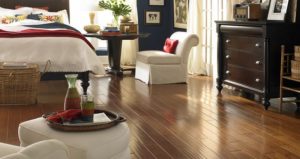 Hardwood flooring brings a wonderful element of style and warmth to any room. However, if you’re interested in installing hardwood flooring in your home, there are a few factors you need to know—like the difference between solid and engineered hardwood. While both options are made of real wood, there are a few significant differences between the two worth noting.
Hardwood flooring brings a wonderful element of style and warmth to any room. However, if you’re interested in installing hardwood flooring in your home, there are a few factors you need to know—like the difference between solid and engineered hardwood. While both options are made of real wood, there are a few significant differences between the two worth noting.
Solid Wood
- Constructed from a single piece of lumber, solid hardwood allows for a uniformed color and grain throughout the entire floor. However, due to its higher quality, solid wood is likely to be slightly more expensive than engineered wood
- Solid wood varies in depth, but typically ranges between 3/4” and 7/16” in thickness
- Due to its tendency to expand and contract with moisture and temperature change, solid wood should never be installed in the basement of a home. This flooring should also always be installed by a professional
- Solid wood flooring can be refinished as many as 10 times throughout its lifetime
Engineered Wood
- Engineered wood is constructed using numerous pieces of lumber and is layered with a solid wood top
- Engineered wood also varies in thickness, but most engineered flooring is 3/4” thick
- Less likely to buckle, gap and react to humidity and temperature fluctuations, engineered hardwood can be installed on any level of your home. This flooring is also much easier to install than solid wood and can sometimes be installed without the help of a professional
- Engineered wood flooring can be refinished only once or twice over its lifetime
When it comes to deciding between solid or engineered flooring, here are a few additional factors to consider:
- The location of your floor: You can classify the location of your hardwood flooring into three basic categories; on grade (ground level), above grade (second level or higher) and below grade (below the ground floor). As mentioned above, solid hardwood is not an ideal flooring solution for below grade level, or basements. Basements have a tendency to trap moisture, which can ruin your hardwood. When it comes to basements, engineered hardwood is almost always the safer option
- Your subfloor: Your subfloor is the flooring you will be installing your new flooring on top of. If you are installing new flooring over concrete, engineered hardwood is the best option. If you are installing new flooring over plywood or existing wood floors, solid or engineered hardwood are both valid options
- Moisture: In rooms where moisture is an obvious issue, such as the bathroom, neither solid nor engineered hardwood is a good choice. Moisture-filled rooms—like your bathroom—should be floored with either tile or stone—not wood!
Looking to install beautiful new hardwood flooring in your home? Carpetland USA has a wonderful variety of hardwood flooring options to choose from, for any level of your home. Stop by your local Carpetland USA location to talk with one of our sales representatives about the hardwood flooring options we have today!